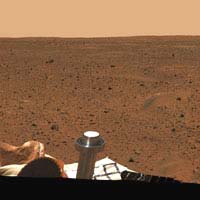Spirit’s Surroundings Beckon in Color Panorama

Portion of Spirit’s first 360-degree image <br>Image credit: NASA/JPL/Cornell
The first 360-degree color view from NASA’s Spirit Mars Exploration Rover presents a range of tempting targets from nearby rocks to hills on the horizon.
“The whole panorama is there before us,” said rover science- team member Dr. Michael Malin of Malin Space Science Systems, San Diego. “It’s a great opening to the next stage of our mission.”
Spirit’s flight team at NASA’s Jet Propulsion Laboratory, Pasadena, Calif., continues making progress toward getting the rover off its lander platform, but expected no sooner than early Thursday morning. “We’re about to kick the baby bird out of its nest,” said JPL’s Kevin Burke, lead mechanical engineer for the rover’s egress off the lander.
The color panorama is a mosaic stitched from 225 frames taken by Spirit’s panoramic camera. It spans 75 frames across, three frames tall, with color information from shots through three different filters. The images were calibrated at Cornell University, Ithaca, N.Y., home institution for Dr. Jim Bell, panoramic camera team leader.
Malin said, “Seeing the panorama totally assembled instead of in individual pieces gives a much greater appreciation for the position of things and helps in developing a sense of direction. I find it easier to visualize where I am on Mars when I can look at different directions in one view. For a field geologist, it’s exactly the kind of thing you want to look at to understand where you are.”
Another new image product from Spirit shows a patch of intriguing soil near the lander in greater detail than an earlier view of the same area. Scientists have dubbed the patch “Magic Carpet” for how some soil behaved when scraped by a retracting airbag.
“It has been detached and folded like a piece of carpet sliding across the floor,” said science-team member Dr. John Grotzinger of Massachusetts Institute of Technology, Cambridge.
Spirit’s next step in preparing to drive onto the surface of Mars is to sever its final connection with the lander platform by firing a cable cutter, which Burke described as “an explosive guillotine.” The planned sequence after that is a turn in place of 115 degrees clockwise, completed in three steps over the next two days. If no obstacles are seen from images taken partway through that turn, drive-off is planned toward the northwestern compass point of 286 degrees.
Spirit landed on Mars Jan. 3 after a seven-month journey. Its task is to spend the next three months exploring rocks and soil for clues about whether the past environment in Gusev Crater was ever watery and suitable to sustain life. Spirit’s twin Mars Exploration Rover, Opportunity, will reach Mars Jan. 24 PST (Jan. 25 Univeral Time and EST) to begin a similar examination of a site on a broad plain called Meridiani Planum, on the opposite side of the planet from Gusev Crater.
NASA JPL, a division of the California Institute of Technology, Pasadena, manages the Mars Exploration Rover project for NASA’s Office of Space Science, Washington. For information about NASA and the Mars mission on the Internet, visit: http://www.nasa.gov. Additional information about the project is available on the Internet at: http://marsrovers.jpl.nasa.gov. Mission information is also available from Cornell University, at: http://athena.cornell.edu.
Guy Webster (818) 354-5011
Jet Propulsion Laboratory, Pasadena, Calif.
Donald Savage (202) 358-1547
NASA Headquarters, Washington
Media Contact
All latest news from the category: Physics and Astronomy
This area deals with the fundamental laws and building blocks of nature and how they interact, the properties and the behavior of matter, and research into space and time and their structures.
innovations-report provides in-depth reports and articles on subjects such as astrophysics, laser technologies, nuclear, quantum, particle and solid-state physics, nanotechnologies, planetary research and findings (Mars, Venus) and developments related to the Hubble Telescope.
Newest articles

First-of-its-kind study uses remote sensing to monitor plastic debris in rivers and lakes
Remote sensing creates a cost-effective solution to monitoring plastic pollution. A first-of-its-kind study from researchers at the University of Minnesota Twin Cities shows how remote sensing can help monitor and…

Laser-based artificial neuron mimics nerve cell functions at lightning speed
With a processing speed a billion times faster than nature, chip-based laser neuron could help advance AI tasks such as pattern recognition and sequence prediction. Researchers have developed a laser-based…

Optimising the processing of plastic waste
Just one look in the yellow bin reveals a colourful jumble of different types of plastic. However, the purer and more uniform plastic waste is, the easier it is to…


